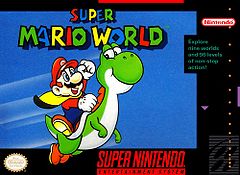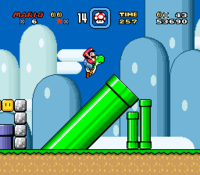Super Mario World: Difference between revisions
m (Text replacement - "\[\[(:)?Image:" to "[[$1File:") |
m (Text replacement - ".svg|50px]]" to ".svg|50px|class=invert]]") |
||
| Line 4: | Line 4: | ||
|title = Super Mario World | |title = Super Mario World | ||
|image = [[File:SMWbox.jpg|240px]] | |image = [[File:SMWbox.jpg|240px]] | ||
|caption = [[File:MarioSymbol.svg|50px]][[File:YoshiSymbol.svg|50px]] | |caption = [[File:MarioSymbol.svg|50px|class=invert]][[File:YoshiSymbol.svg|50px|class=invert]] | ||
North American boxart for Super Mario World. | North American boxart for Super Mario World. | ||
|developer = Nintendo EAD | |developer = Nintendo EAD | ||
Revision as of 03:07, June 11, 2021
| Super Mario World | |
|---|---|
  
North American boxart for Super Mario World. | |
| Developer(s) | Nintendo EAD |
| Publisher(s) | Nintendo |
| Released | Super Nintendo Entertainment System: Game Boy Advance: Virtual Console: |
| Genre(s) | Platformer |
| Mode(s) | Single-player Two-player |
| Platform(s) | Super Nintendo Entertainment System, Game Boy Advance, Virtual Console |
| Article on Super Mario Wiki | Super Mario World |
Super Mario World (スーパーマリオワールド, Super Mario World), commonly abbreviated as SMW, is an SNES/Super Famicom game that featured Mario and Luigi and introduced the character Yoshi. It was released on November 21, 1990 in Japan, August 13, 1991 in North America, and April 11, 1992 in Europe. It was also released later for the Game Boy Advance and the Virtual Console for the Wii.
This game appears as a Masterpiece in Super Smash Bros. Brawl and Super Smash Bros. for Wii U. In Brawl, it can be played for 120 seconds and starts at Yoshi's Island 2 with Mario. It must be unlocked by playing on the Melee Yoshi's Island stage three times. In Super Smash Bros. for Wii U, the masterpiece is available from the start. It can be played for 180 seconds and starts at the map of the first world, Yoshi's Island.
In the Super Smash Bros. series

Fighter
Yoshi debuted in this game. He can be found in some blocks and ridden.
Moves
Mario's side special, Cape, is based on the Cape Feather power-up in this game, which gives Mario a cape he can use to swing and damage enemies as well as fly once he gets a running start. The Mario Tornado and Luigi Cyclone both may come from the Spin Jump in this game.
Yoshi's Final Smash, Super Dragon, is based on powers Yoshi can obtain in Super Mario World, depending on what color Koopa shells Yoshi eats, specifically the powers obtained after eating a Red or Blue Shell. The stars that appear when Yoshi lands after a Yoshi Bomb may be a loose reference of how a Yellow Yoshi produces damaging clouds of dust when he lands.
Bowser Jr. uses the Clown Car, which first appeared in this game, for most of his moves. His down special move, Mechakoopa, also comes from this game. Mechakoopas first appear in this game and are thrown by Bowser in the final stage of the boss battle.
Stages
The Melee stage Yoshi's Island, which reappears in Brawl and Wii U, comes from this game. It is based on the standard overworld levels. Super Mario World is also one of the four game styles represented in Super Mario Maker.
Music
"Yoshi's Island", "Title / Ending (Super Mario World)", "Ground Theme (Super Mario World)", "Fortress Boss (Super Mario World)" and "Super Mario World Medley" come from this game. "Yoshi's Island" is a banjo-based remix of the song that plays on most athletic levels. Later on in this remix, a woodblock beat will be added. This is derived from how a woodblock beat is added to the music whenever Mario rides Yoshi. "Title / Ending (Super Mario World)" is a medley of the song that plays on the title screen and the song that plays on the ending. "Super Mario World Medley" starts off with the "level start" jingle, followed by the ground level variant of the theme used in the game's levels. It leads into an interlude with percussion used whenever playing a level while riding Yoshi before continuing the ground level theme until it goes to the drum roll after clearing the level tape, followed the Special World/Super Star theme before finally looping back into the ground level theme. The ground theme is taken directly from this game. "Fortress Boss (Super Mario World)" is a song that has a Latin-style theme that plays when Mario battles a castle boss.
Others
There is a trophy of Mario riding Yoshi in Melee that was distributed at certain Nintendo events in Japan. The trophy can now only be accessed in NTSC versions with the help of a hacking device; it was removed entirely from the PAL version of the game.
| Masterpieces in Super Smash Bros. Brawl | |
|---|---|
| Starter games | Ice Climber · Kid Icarus · Kirby's Adventure · Star Fox 64 · Super Mario Bros. · Super Metroid · The Legend of Zelda |
| Japan-only games | EarthBound · Fire Emblem: Mystery of the Emblem |
| Unlockable games | Donkey Kong · F-Zero · Super Mario Bros. 2 · Super Mario World · The Legend of Zelda: Ocarina of Time |
| Masterpieces in Super Smash Bros. for Wii U | |
|---|---|
| Starter games | Balloon Fight · Donkey Kong · F-Zero · Kid Icarus · Kirby Super Star · Kirby's Dream Land · Mega Man 2 · Metroid · Pac-Man · Pilotwings · Super Mario Bros. · Super Mario Bros.: The Lost Levels · Super Mario Kart · Super Mario World · Super Metroid · The Legend of Zelda · Wrecking Crew · Zelda II: The Adventure of Link |
| Unlockable games | Dr. Mario · EarthBound · Kirby's Adventure · Punch-Out!! Featuring Mr. Dream · Yoshi |
| Japan-only games | Fire Emblem: Shadow Dragon and the Blade of Light |